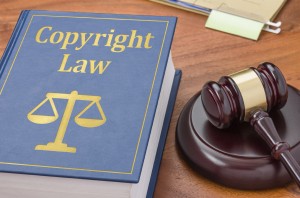Breaking The Wall: Copyright Conflict Reaches The Supreme Court
A circuit split on copyright registrations means SCOTUS must finally act.
 Esoteric copyright issues do not often traverse the tortuous halls of justice to wind up on the steps of the vaunted Supreme Court. But such is the sitch in the matter of Fourth Estate Public Benefit Corporation v. Wall-Street.com, LLC, a dispute between a copyright licensor and licensee that was recently anointed via writ by The Nine (or The Eight as it currently stands). At issue is nothing less than the very fate of the United States Copyright Office registration procedure. Or at least the degree to which copyright holders are burdened with the outdated statutory requirement of obtaining an otherwise irrelevant registration certificate from the Copyright Office before initiating litigation.
Esoteric copyright issues do not often traverse the tortuous halls of justice to wind up on the steps of the vaunted Supreme Court. But such is the sitch in the matter of Fourth Estate Public Benefit Corporation v. Wall-Street.com, LLC, a dispute between a copyright licensor and licensee that was recently anointed via writ by The Nine (or The Eight as it currently stands). At issue is nothing less than the very fate of the United States Copyright Office registration procedure. Or at least the degree to which copyright holders are burdened with the outdated statutory requirement of obtaining an otherwise irrelevant registration certificate from the Copyright Office before initiating litigation.
The Copyright Act, at 17 U.S.C. § 411(a), states that the Copyright Office must approve or deny a “registration” for the work at issue before an artist can file suit for infringement. The question before the Supremes will be: does this registration exist at the moment the artist registers the work by completing and filing the registration application form or at the moment the Copyright Office registers the work by approving the form and assigning a registration number (which assignment, notably, is then backdated to the date the artist filed)? The statute’s language seems to provide support for both interpretations.
Given the Copyright Act’s lack of clarity in this regard, it is not surprising that there is discord amongst the Circuits regarding the somewhat groovy and existential question of when a copyright registration comes into being for purposes of satisfying the Copyright Act. The Fifth, Seventh (for the most part), Eighth, and Ninth Circuits follow the “application approach,” which requires a copyright owner to plead that he or she has filed “the deposit, application, and fee required for registration,” 17 U.S.C. § 411(a), when filing a suit for infringement. The Tenth and Eleventh follow the more onerous “registration approach,” which requires that a litigant plead that the Copyright Office has acted on the registration. The First and Second Circuits seem to swing both ways, with district courts in those Circuits coming down on both sides of the debate.

The Ethical use of Generative AI

From a practical standpoint, the application approach is far superior, as it does not leave potential litigants at the mercy of the Copyright Office’s whims and foibles. The Copyright Office does a fantastic job processing the multitude of registration forms that it receives on the daily, but it sometimes takes months or even years to approve a registration and at other times the registration form is lost or misplaced and not acted upon at all. To force a copyright holder with an otherwise valid claim to delay their lawsuit while waiting for the Copyright Office to address their registration is wholly inefficient and serves no purpose.
And it can be needlessly harmful given that the statute of limitations for copyright cases is three years. If an artist submits their registration form later in the statutory period, they will be effectively denied the portion of that period spent waiting for the Copyright Office to act. And, if the Office does not act before the end of the statutory period, the statute will expire and the claim will fail for a wholly arbitrary reason. No concession is made in the Copyright Act’s text to account for the portion of the statutory period spent waiting for the Copyright Office to act on a registration.
The application approach also makes more sense when you consider that the Copyright Office’s decision on the registration application is a litigation nullity; so long as it approves or denies the registration, the copyright holder can proceed in court. If the registration approach were to be adopted, it would create the bizarre situation where it would be more beneficial to a litigant to have the Copyright Office quickly reject their registration than approve it months or years down the road.
The import of the registration is further eroded by the fact that judges are free to disregard the Copyright Office’s decision on registrability. Registration, which used to trigger protection under the 1909 Copyright Act, was demoted under the 1976 Copyright Act, which made fixation of the work in a tangible medium the triggering act. So, while all practical, policy, and historical considerations seem to favor the application approach, the Eleventh Circuit in Fourth Estate adopted the registration approach, relying on a textual analysis that found support in the statute’s language.
Sponsored

How To Maximize Productivity With Westlaw Precision With CoCounsel


The Ethical use of Generative AI


Mitigating M&A Cyber Risk: Pre- & Post-Acquisition Due Diligence

How To Maximize Productivity With Westlaw Precision With CoCounsel

Section 408(a) of the Copyright Act states, “the owner of copyright … may obtain registration of the copyright claim by delivering to the Copyright Office the deposit specified by this section, together with the application and fee specified by sections 409 and 708.” This would seem to support the application approach, especially when coupled with the fact that the approved registrations bear the date on which these deliverables are made. But, elsewhere the Act states that “registration of [a] copyright … has [not] been made” until “the Register … register[s] the claim.” And Section 410(d) also supports the registration approach: “[t]he effective date of a copyright registration is the day on which an application, deposit, and fee, which are later determined by the Register of Copyrights or by a court of competent jurisdiction to be acceptable for registration, have all been received in the Copyright Office.”
The “later determined” language supports the “registration approach” and the Eleventh Circuit’s adoption of same. But the language is open to different interpretations, which opens the analysis to concerns beyond the contours of the statute.
For example, the vast majority of artists cannot afford or do not have the wherewithal to register all of their works. Indeed, the registration procedures set by the Copyright Office, while palatable to copyright attorneys, can be daunting to artists. The end result is that it is rare to encounter an artist who has had the foresight to register a work before it was copied. These artists are forced to file registrations before going to court and if they also had to wait for months or years for the Copyright Office to act on the registrations, justice would be unduly delayed.
Another indication of the registration’s lack of import is that international artists or domestic artists that first publish a work internationally are excused from this registration scheme entirely. Under the registration approach, U.S. artists would be forced to wait months or years for the opportunity to go to court while international artists are free go to court the day after discovering an infringement.
The availability of injunctive relief to copyright holders without registrations also seems to indicate that an approved registration should not be required. Section 502(a) allows “temporary and final injunctions on such terms as [the court] may deem reasonable to prevent or restrain infringement of a copyright.” Importantly, the language addresses a “copyright” and not a “registered copyright.” Thus, courts have held injunctive relief to be available even when a work is unregistered. Allowing injunctive relief without an approved registration while denying monetary damages to those in want creates a distinction where none exists. It would also create an incentive for litigants to seek injunctive relief just to get their case into court, particularly if a statute is about to lapse, and then add the request for monetary damages after the approved registration issues.
Sponsored

New Report - Are Small Firms Achieving Their Legal Tech Goals?

Attention Buyer: Not All Legal AI Models Are Created Equal
Similarly, under the registration approach, if a copyright dispute arises between artists, the potential plaintiff is barred from court until the registration is approved, but the alleged infringer can file a declaratory relief action without even filing a registration form. This provides a temporal and potentially forum-based advantage to the infringer, which is certainly not in the spirit of the Copyright Act.
The copyright registration, a one-page form that includes basic information about a work of art, is already the key to the courthouse doors and an artist without one is no more than a supplicant without a bowl. The application approach to registration is the less onerous of the two and, given the Copyright Act’s stated intent of encouraging the arts, is the better one.
 Scott Alan Burroughs, Esq. practices with Doniger / Burroughs, an art law firm based in Venice, California. He represents artists and content creators of all stripes and writes and speaks regularly on copyright issues. He can be reached at [email protected], and you can follow his law firm on Instagram: @veniceartlaw.
Scott Alan Burroughs, Esq. practices with Doniger / Burroughs, an art law firm based in Venice, California. He represents artists and content creators of all stripes and writes and speaks regularly on copyright issues. He can be reached at [email protected], and you can follow his law firm on Instagram: @veniceartlaw.







